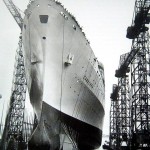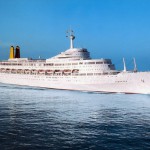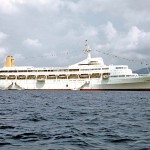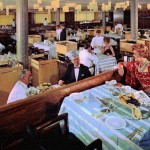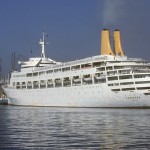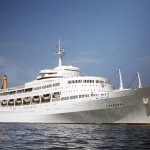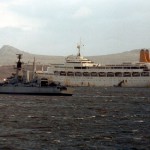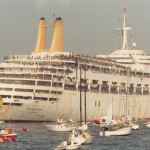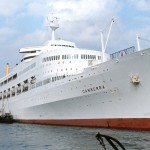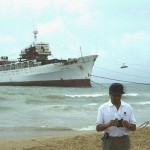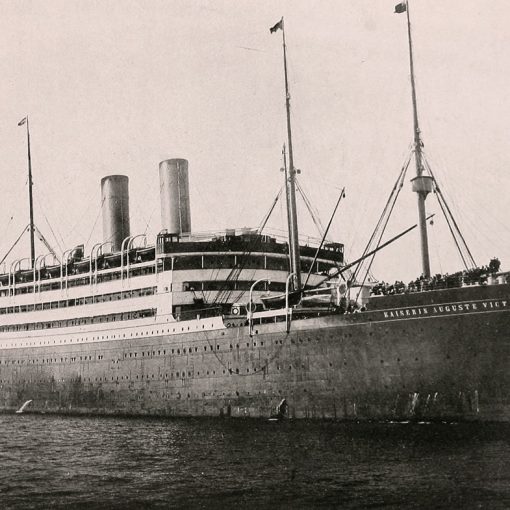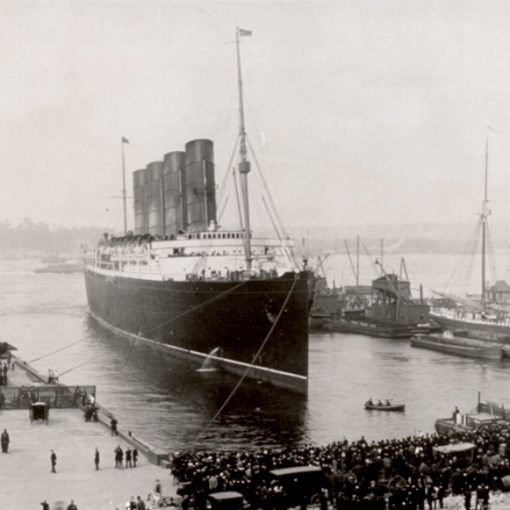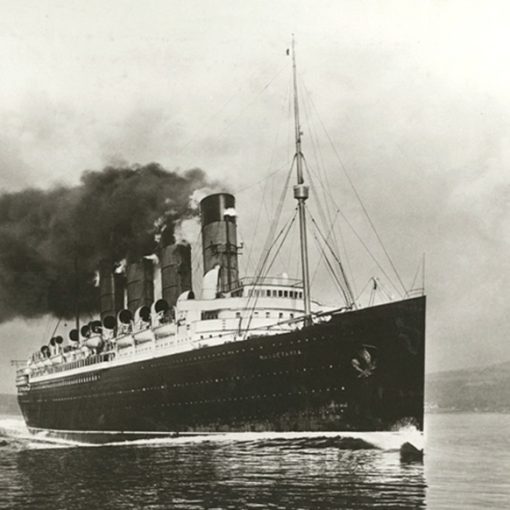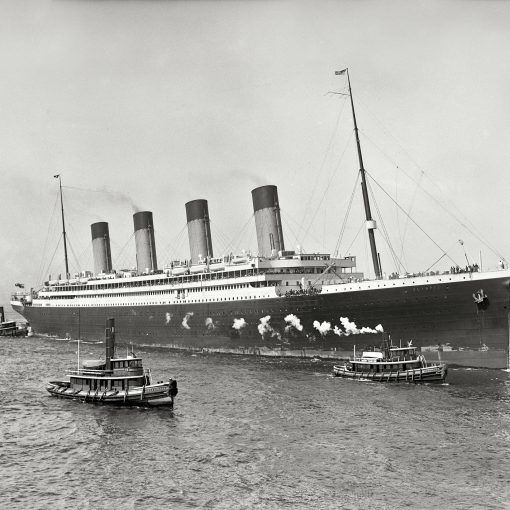1961 – 1997
In the wake of the Second World War, Great Britain found itself in a precarious situation. Although the allied forces had emerged victorious from the great conflict, peace had been achieved at a high cost. The nation was facing virtual bankruptcy, and its inhabitants were getting tired of the poor living circumstances. Many of them were now beginning to look for a place to start over. And so, like in the late 1800s and early 1900s, a wave of emigration started. But unlike their countrymen before them, these new emigrants would not travel west across the North Atlantic to the United States. Although some found their way to Canada, most of these new migrants set their sights for Australia and New Zealand.
The passenger trade to Australia flourished. But ironically, the British emigrants could not be guaranteed passage on a British liner. Half of Britain’s merchant fleet had been destroyed during World War II, and due to the bad economics and material shortage, British shipyards could not build new ships at the rate they wanted to. But by the mid-1950s, the Marshall-plan had helped the financial situation in Europe to recuperate. Things were looking better and better, and this was also reflected in the shipping companies. Business was improving, and with this in mind the P&O Line placed an order for two new large liners. One of them would be built in the famous yards of Harland & Wolff in Belfast.
On September 23rd 1957, the first keel plates of yard no. 1621 was laid down on Harland & Wolff’s slipway 14. For months, engineers from the shipyard along with P&O men had pondered over plans and designs in order to create the finest ship possible. The building of the ship went on, but it took six months before its name was decided upon. In March of 1958, it was publicly announced that she would bear the name Canberra, an aboriginal word meaning ‘meeting place by the water’.
The great ship now growing on the stocks soon became a great symbol of better times to come. She was the largest ship built at Harland & Wolff since White Star’s Britannic in 1914. Finally, after two and a half years of construction, the new ship was ready to enter her proper element. March 16th 1960 was a cold and wet day in Belfast. Nevertheless, this great event had not failed to attract its share of spectators. 300 invited guests were present, in addition to the 11,000 people crowding the banks of the Musgrave Channel.
Dame Pattie Menzies, wife of the Australian Prime Minister had been given the honour of christening the new ship. Instead of the traditional champagne, she had brought with her a large bottle of Australian wine for the ceremony. Smashing it across the bows, she baptised the ship, which then slipped majestically into the waters. The great Canberra was born. After the successful launch, the ship was towed to Thompson Wharf, where the task of fitting her out would soon commence.
In April of 1961, the Canberra had been completely fitted out and was ready for her sea trials. These took place in Belfast Lough on April 29th. The ship sported a very modern profile, as she had been built after the very latest standards. Her machinery had been placed aft, leaving the best parts of the ship for passenger areas. As a result, the ship’s funnels were also placed towards the stern. The pair of yellow funnels had been placed side-by-side, instead of the older style of placing them after one another. The engines themselves were also of a quite different type. Like on the Normandie 25 years earlier, the Canberra was equipped with turbo-electric engines powered by steam turbines.
Outwardly, perhaps the most striking feature was the arrangement of the ship’s lifeboats. Instead of placing them up on a boat deck, they were stationed in bays in the hull closer to the waterline. This innovative arrangement is still used on modern cruise ships like the Destiny or Grand Princess. Furthermore, much of the superstructure had been constructed out of aluminium, thereby making the ship lighter and therefore causing less fuel consumption.
During her sea trials, a major flaw was discovered in the Canberra’s design. When going at high speed, the bow lifted itself out of the water because of the weight of the engines. To remedy this problem, the ship was sent to Southampton where some of her forward compartments were filled with ballast as counterweight. Otherwise, the trials had been successful. Canberra performed various manoeuvres and managed to achieve a top speed of 29.27 knots over the measured mile. Then, the Canberra was officially handed over to her owners – P&O. She was sent to Southampton, from where she would soon sail on her maiden voyage to Australia. When the ship docked at the new £300,000 cruise terminal, Harland & Wolff workers were still busy inside, finishing the final touches on her interiors.
On June 2nd 1961, the time had arrived for the Canberra to enter service on the Australian run. The anticipation of the public could not have been mistaken, as the ship was booked almost solid in spite of the somewhat off-season voyage. Calling at such ports as Gibraltar, Naples, Colombo, Fremantle and Melbourne, the Canberra finally arrived in Sydney. The maiden voyage had not been as successful as P&O had hoped for, though. Leaking tubes had caused problems with one of the condensers, and this had resulted in a complete power failure. As a result, the air condition malfunctioned, and the passengers were soon facing a very unpleasant heat on board. The condenser problem continued, and when Canberra arrived in Sydney she was some 24 hours behind schedule. Nevertheless, she was given a hearty welcome by the city, where a great flotilla of small boats escorted her into the harbour. While in port, the crew managed to fix the troubling condenser, and the voyage could continue.
Crossing the Pacific, the Canberra arrived at Honolulu on July 12th. She then continued to Vancouver, San Francisco and Los Angeles. She then made a complete turnaround, and headed back to Southampton more or less the same way. On September 4th, she was back in her familiar port, after having steamed 42,000 miles. A great ship, she and her running mate, the Oriana, had cut the passage from Southampton to Sydney by a whole week.
Just as the Canberra was about to settle into her service, she once again encountered problems on her fourth round voyage. The boilers were once again misbehaving, and the turbo generators were also not working well. So it was decided that instead of turning around in Sydney and head for home as usual, the Canberra would instead be sent east and through the Panama Canal, from where she would then cross the Atlantic and continue home.
Upon her return to Southampton, the Canberra was taken in for an overhaul. Her machinery problems had to be solved before she could re-enter service. While this was done, the ship was also given a small exterior facelift. Her funnels, which had been stained by the smoke at the tops, were given two black five-foot extensions, giving them a better appearance. When the Canberra returned from the overhaul, her performance was much better. She continued her Southampton-Australia service and sometimes made occasional cruises to destinations such as Gibraltar and Madeira. But another serious incident wasn’t far off in the future. On January 4th 1963, a fire broke out in the engine room. The fire completely destroyed the electrical switchboard, and the ship lost all power. Fortunately, the fire was soon under control, but the Canberra was still dead in the water.
By the next morning, the engine room crew had managed to partially restore electrical power, and the ship headed for Grand Harbour where repairs could be carried out. It did not go very fast, though. Going along at only four knots, the engineers could later increase it to ten. The Canberra limped to Malta, where she arrived the next day. The passengers were brought to their destinations by aeroplane, and when temporary repairs had been made, the Canberra was sent to her builders in Belfast for yet another overhaul. This lasted until the following May, and the ship then went through new sea trials. Everything was OK, and the Canberra could return to service again. This incident could have damaged the Canberra’s reputation severely but strangely, this did not seem to be the case. On May 24th, she left Southampton with a new record of passengers on board – 2,266 people. The public did indeed have a great affection to the great Canberra.
Throughout the 1960s, the Canberra enjoyed a career with few mishaps and she was one of the most popular ships on the run, along with the Oriana. However, by the end of the decade, the scene was changing. The emigration to Australia stagnated, and the commercial airliners were swiftly taking over the trade. If the Canberra was to stay in business, P&O would have to come up with new duties for her.
And so, P&O decided to try an old recipe – cruising. Canberra was sent to New York, from where she would sail on Caribbean cruises. But this venture was an utter failure. Bookings were low, and after only two cruises, P&O decided to have Canberra laid up at the mouth of the Cape Fear River. Although she then returned to New York and made another nine cruises, P&O soon announced that the Canberra would be sent to the ship breakers at the end of the 1973-season. Luckily, this would not be the case. Suddenly, there was an increase in P&O’s cruise bookings. So, they decided to keep the Canberra, and have her refitted as an all-out cruise ship with only one class. During the refit, more cruising-suitable amenities were added, and the ship’s capacity was decreased to only 1,700 people.
Refitting the Canberra soon turned out to be just the magic stroke she needed. Operating from Southampton with shorter cruises in the summer and a world cruise in the wintertime, the Canberra was soon known as one of the most popular cruise ships. P&O was indeed enjoying booming business, and this was not least evident in the company’s profits – £4.1 million in 1976, as opposed to a loss of £6.9 million in 1975. Continuing with these duties, the Canberra went on making money for her owners. But as a new decade arrived, it brought along some changes. Fuel costs were soaring high and with this in mind, Canberra was taken in and fitted with new combustion equipment and a new set of propellers. Thus, her service speed would be slightly reduced but she would be more economical to operate. With the fact that P&O spent money on her, it was evident that the Canberra would be around for a while longer. And she the passengers still loved her. But no matter how successful the Canberra was in her cruising duties, her most famous time would come in 1982.
In April of 1982, the British colony of the Falkland Islands was invaded by Argentinian troops. Argentina had claimed the rights to these islands for years, because of their geographical location. Soon they controlled the only major airstrip on the islands, and Britain no longer had the possibility of bringing in troops by air. Any military actions had to come by sea, and like so many times through the history of the British Empire, the nation was forced to turn to its merchant liners for help. There was one problem, though. In earlier conflicts, there had been a great amount of vessels flying the British flag. Now, there were only two liners that did so – Cunard’s Queen Elizabeth 2 and P&O’s Canberra. Joining their earlier counterparts in the annals of history, these two ships were now called in to do war duties.
The Canberra was steaming homeward through the Mediterranean when she on April 2nd 1982 received a message from head office informing the crew that the ship was to be taken in as a STUFT (Ship Taken In From Trade). Five days later she arrived in Southampton, and as soon as her passengers had been offloaded, work began on preparing the Canberra for wartime use. The most apparent change was the three helicopter pads that were welded onto the ship’s superstructure. Only two days later, the Canberra left for the Falkland Islands. On board were members of the 40th and 42nd Commando Royal Marines and 3rd Para.
The Canberra soon reached the war zone. On the morning of May 21st, the Canberra was given orders to enter the Bay of San Carlos and start disembarking troops. She was accompanied by various navy vessels. An extremely risky operation, the Argentine air force was swarming around them. The British vessels were under heavy fire, and the crew on board the Canberra was worried. With the ship’s superstructure largely made out of aluminium, a fire would have been devastating.
The Canberra started off-loading troops at 10 a.m., with enemy aircraft all the time coming over the hills with orders to attack her. This dangerous task continued through the afternoon, and that night the ship weighed anchor and left San Carlos. Miraculously, she had not been hit a single time. How the Argentinean pilots had managed to miss her again and again was indeed a great mystery. The Canberra had been a virtual sitting duck, with her white, gleaming hull making her an easy target. But she had been very fortunate, and had done her job brilliantly.
But her duties were not over yet. The QE2 had also been requisitioned as a trooper, but it had been decided that she was not to enter the war zone. A possible loss of the ship bearing the name of the Sovereign was more than the British politicians could bear, and so it was up to the Canberra to face the real danger. The two ships rendezvoused at South Georgia, and the troops on the QE2 were transferred to Canberra. She then turned around to head back to the Falklands. This time, the disembarkation of troops went off more or less undramatically. Protected by fog, the troops on the Canberra were carried off by small landing crafts or helicopters. By the next morning the off-loading was complete.
On June 14th, the Argentines surrendered. The Canberra was used to transport prisoners of war, and she was then ordered to repatriate British troops. On June 25th, she finally set off for home. A little more than two weeks later, the Canberra arrived off Southampton on July 11th. Although streaked with rust and a bit worn-down looking, she still looked every inch a lady when she entered the waters of this legendary port. She was given a remarkable welcome, as hundreds of small boats had sailed out to escort her into the harbour. Thousands of people were lining the docks to greet the Canberra – or ‘The Great White Whale’, as she had now become known.
Following this remarkable time in her life, the Canberra was taken in to be turned back into a luxury cruise ship. At the end of the summer, she was ready to resume her regular service. On September 11th, she left on her first post-war cruise. Her popularity had not faded during the war – more the opposite – and she was fully booked for a number of cruises. This very profitable and popular service continued, and in 1986 the Canberra was given a rather extensive overhaul at the yards of Lloyd Werft in Germany. With this overhaul, the Canberra’s interiors were brought up to date and the whole ship was more or less renewed. Even the crewmembers were given a new style of uniforms.
But by the end of the 1980s, the Canberra began showing signs of age. In 1989, one of the ship’s propulsion motors malfunctioned and resulted in costly repairs. The Great White Whale was getting old, and in 1991 P&O announced that a replacement ship was to be built in the coming years. The following year the order was placed for a new 67,000-ton vessel at Lloyd Werft. For Canberra, the writing was on the wall. Four years later, in 1996, P&O officially announced that the Canberra was to be taken out of service on September 30th, 1997. And so she was, but only after she had made a final farewell cruise to the Mediterranean.
Now, the Canberra awaited her future. Although Premier Cruise Line had made a bid for the old ship, P&O had already decided that they did not want the Canberra to operate under a different flag. On October 10th, P&O announced that the Canberra had been sold to ship breakers in Pakistan. Indeed, the end was nigh. The Canberra sailed to her place of final demolition under her own steam. She arrived off Karachi on October 28th. The scrappers had decided to beach the ship and then cut her up as she lay. On October 31st, the Canberra beached herself at almost full speed, and the actual breaking up could soon commence. Things did not go quite as planned, though. The scrappers had expected to cut the ship up in a matter of three months, but it would take them well over a full year. Nevertheless, the Canberra was finally completely gone by the end of 1998. All that is left now, are the memories of The Great White Whale.
Specifications
- 818 feet (249.9 m) long
- 102 feet (31.2 m) wide
- 45,733 gross tons
- Steam turbo-electric engines turning two propellers
- 27.5 knot service speed
- Passenger capacity of 2,272 people as originally built, reduced to 1,700 when refitted as a cruise ship

